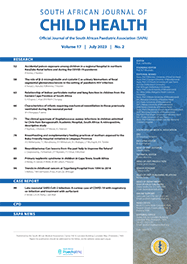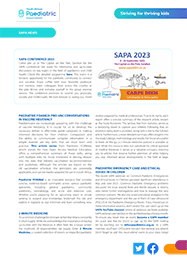Articles

Treatment and outcome of hospitalised, very young, HIV-infected children
Abstract
Methods: A retrospective case review was completed at Red Cross Children’s Hospital during mid-2006. The perinatal management, disease severity, and hospital outcome were analysed. In a sub-analysis, the disease profile and outcome of admitted children aged less than and greater than 6 months were compared over the latter 3 months of the study.
Results: 75/121(43.86%) of all HIV-infected children admitted over the study period were <6months old. 69/72(95.83%) of the children, not receiving HAART at admission, qualified according to current WHO treatment criteria. The most frequent cause for admission was pneumonia (54.67%). The inpatient fatality rate was 28%; pneumonia being the most frequent cause of death (61.9%).
52/75(69.33%) of the mothers reported being tested for HIV during pregnancy. 34/37(91.89%) who tested HIV-positive during pregnancy received PMTCT prophylaxis. Children with confirmed/presumed PJP were less likely to have mothers who received PMTCT prophylaxis (18.51% vs 61.7% p=0.0004), and less likely to be receiving cotrimoxazole prophylaxis (14.81% vs 46.81% p=0.006) at admission.
Children >6months were more likely to be receiving cotrimoxazole prophylaxis (65.4% vs. 31.1%, p=0.0008) and HAART (42.3% vs. 6.7%, p=0.00007) at the time of admission. Of those not on HAART, 27/30(90%) had WHO stage 3 or 4 disease. In patient fatality in this group was 13.5%.
Conclusions: Young children constitute a sizable proportion of the inpatient paediatric HIV workload. Comprehensive PMTCT interventions and earlier introduction of HAART may reduce morbidity, hospitalisation rates and mortality.
Authors' affiliations
Heather Finlayson,
Brian Eley,
Full Text
Keywords
Cite this article
Article History
Date published: 2008-01-23
Article Views
Full text views: 2513

.jpg)



Comments on this article
*Read our policy for posting comments here